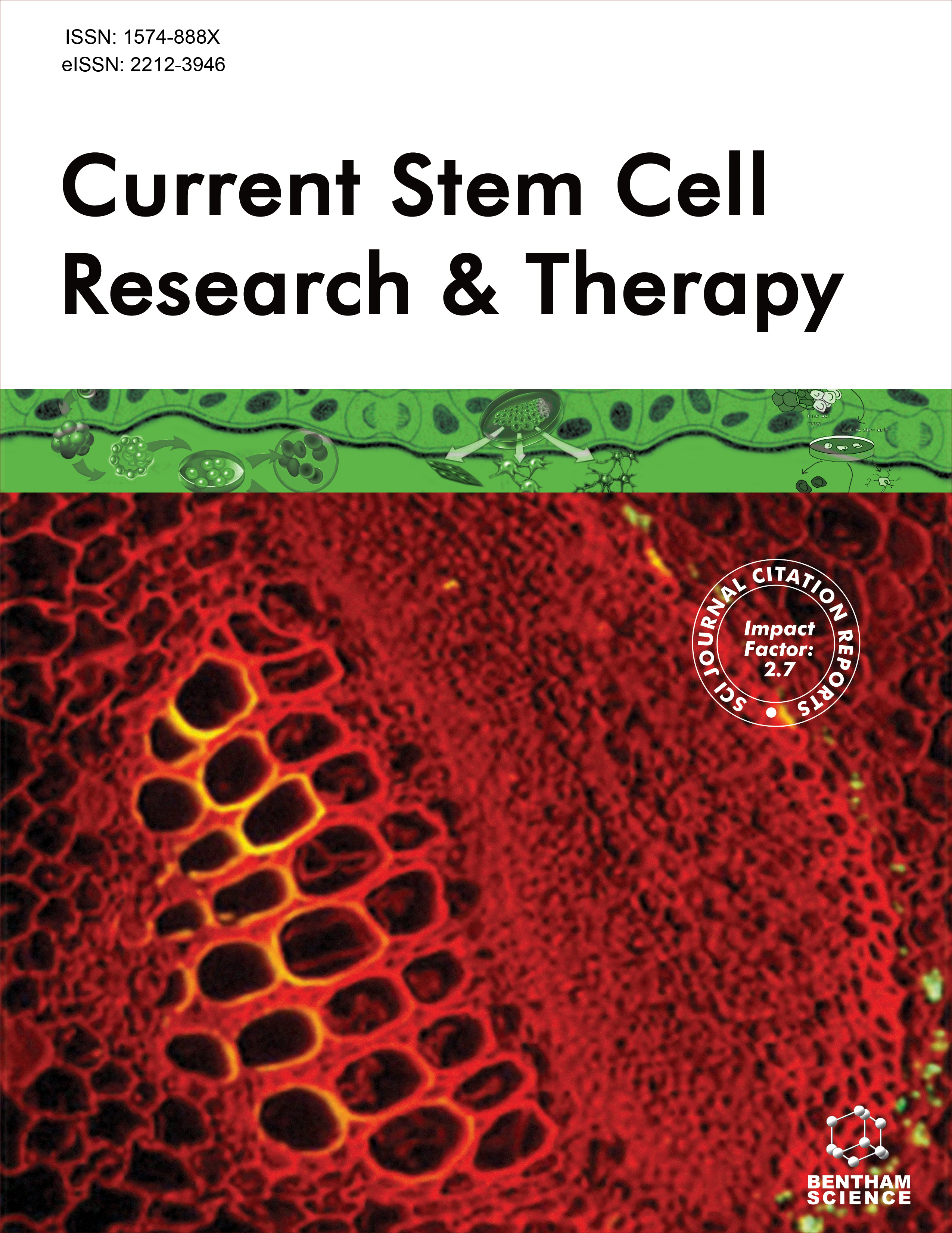- Home
- A-Z Publications
- Current Stem Cell Research & Therapy
- Previous Issues
- Volume 8, Issue 2, 2013
Current Stem Cell Research & Therapy - Volume 8, Issue 2, 2013
Volume 8, Issue 2, 2013
-
-
Therapeutic Potential of Amniotic Fluid Stem Cells
More LessAuthors: Hassan Abdulrazzak, Paolo De Coppi and Pascale V GuillotHuman amniotic fluid cells have been used traditionally as a diagnostic tool for genetic anomalies. More recently it has been recognized that amniotic fluid contains populations of stem cells. Mesenchymal stem cells (AFMSC) were first to be described. These cells are able to differentiate towards mesodermal lineages. More recently cells with broader potential, defined as amniotic fluid stem cells (AFSC), were also isolated. Read More
-
-
-
Human Amniotic Fluid Stem Cells as an Attractive Tool for Clinical Applications
More LessAuthors: Ourania Trohatou, Nicholas P. Anagnou and Maria G. RoubelakisRecent studies support cell based therapies for several diseases. Human fetal stem cells have received much attention for developing new therapeutic strategies. Recently, our group and others have successfully isolated and expanded karyotypically normal stem cells from an alternative fetal source, the human second trimester amniotic fluid (AF) and performed a systematic phenotypic and molecular analysis. Read More
-
-
-
Fetal Mesenchymal Stem Cells in Cancer Therapy
More LessAuthors: Vasiliki Bitsika, Antonia Vlahou and Maria G. RoubelakisThere is compelling evidence that mesenchymal stem cells (MSCs) can be utilized as delivery vehicles for cancer therapeutics. During the last decade, bone marrow MSCs have been used as delivery vehicles for the local production of therapeutic proteins in multiple tumor types, taking advantage of their innate tropism to the tumor site and their low immunogenicity. More recently, MSCs have been isolated from fetal tis Read More
-
-
-
Mesenchymal Stem Cells Derived from Wharton's Jelly of the Umbilical Cord: Biological Properties and Emerging Clinical Applications
More LessIn recent years there seems to be an unbounded interest concerning mesenchymal stem cells (MSCs). This is mainly attributed to their exciting characteristics including long-term ex vivo proliferation, multilineage potential and immunomodulatory properties. In this regard MSCs emerge as attractive candidates for various therapeutic applications. MSCs were originally isolated from the bone marrow (BM) and this population Read More
-
-
-
Enhanced Proliferation and Osteogenic Differentiation of Human Umbilical Cord Blood Stem Cells by L-Ascorbic Acid, In Vitro
More LessAuthors: Naveen Kumar Mekala, Rama Raju Baadhe, Sreenivasa Rao Parcha and Prameela Devi YThe multilineage potentiality of cord blood stem cells has been experimentally proven in a number of cell based therapies. Umbilical cord blood (UCB) derived mesenchymal stem cells (MSCs), on prolonged exposure with Lascorbic acid have been successfully differentiated in to osteoblasts (bone forming cells) without altering the phenotype of the cells. In this case study, the role of L-ascorbic acid on collagen biosynthesis an Read More
-
-
-
A New Approach to CD34+ Hematopoietic Progenitor Cell Counting
More LessAuthors: Pedro Marin, Lluis Jover and Jordi PetrizBackground: In the absence of a gold standard for hematopoietic progenitor counting, the intra-laboratory variation between commonly used strategies for progenitor assessment was compared. Methods and Materials: We used a pool of FITC-conjugated monoclonal antibodies (CD14, CD11b) and PE-CD34 to facilitate CD34 counting, excluding CD14+/CD11b+ bright cells. We compared this protocol with other common Read More
-
-
-
Injection Time-Dependent Effect of Adult Human Bone Marrow Stromal Cell Transplantation in a Rat Model of Severe Traumatic Brain Injury
More LessAuthors: Eun Young Han, Min Ho Chun, Sang Tae Kim and Dong-pyo LimThe object of this study is to evaluate the effects of injecting adult human bone marrow stromal cells (hBMSCs) into rats with severe traumatic brain injury in acute phase and to determine more optimal injection timing between day 1 and day 2 postinjury. The lateral fluid percussion injury model was used. Adult hBMSCs were transplanted into hemisphere to injury sites in the corpus callosum ipsilateral on day 1 (n = 12) or day 7 ( Read More
-
Volumes & issues
-
Volume 20 (2025)
-
Volume 19 (2024)
-
Volume 18 (2023)
-
Volume 17 (2022)
-
Volume 16 (2021)
-
Volume 15 (2020)
-
Volume 14 (2019)
-
Volume 13 (2018)
-
Volume 12 (2017)
-
Volume 11 (2016)
-
Volume 10 (2015)
-
Volume 9 (2014)
-
Volume 8 (2013)
-
Volume 7 (2012)
-
Volume 6 (2011)
-
Volume 5 (2010)
-
Volume 4 (2009)
-
Volume 3 (2008)
-
Volume 2 (2007)
-
Volume 1 (2006)
Most Read This Month
Article
content/journals/cscr
Journal
10
5
false
en


